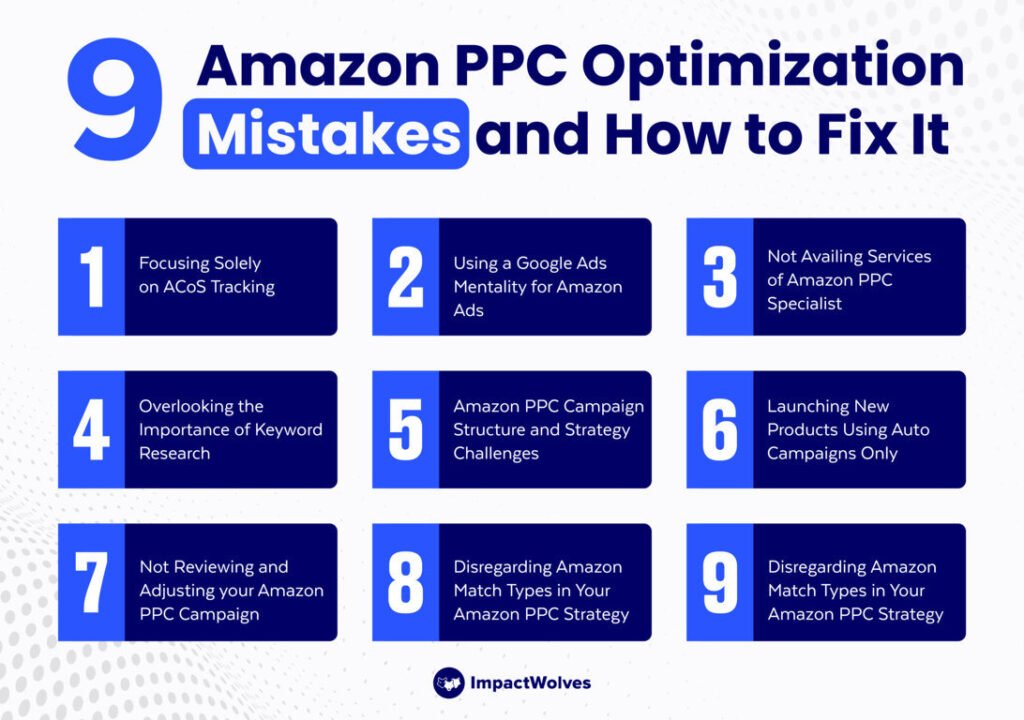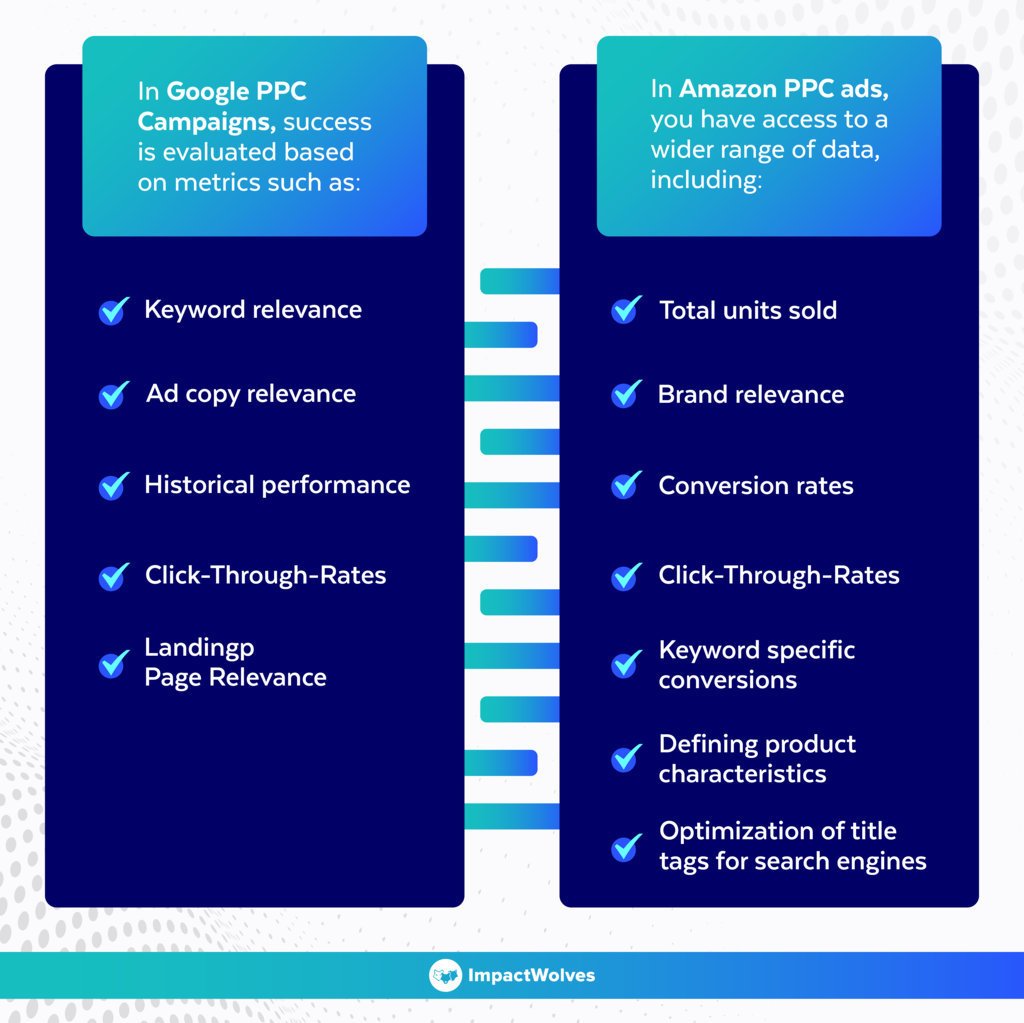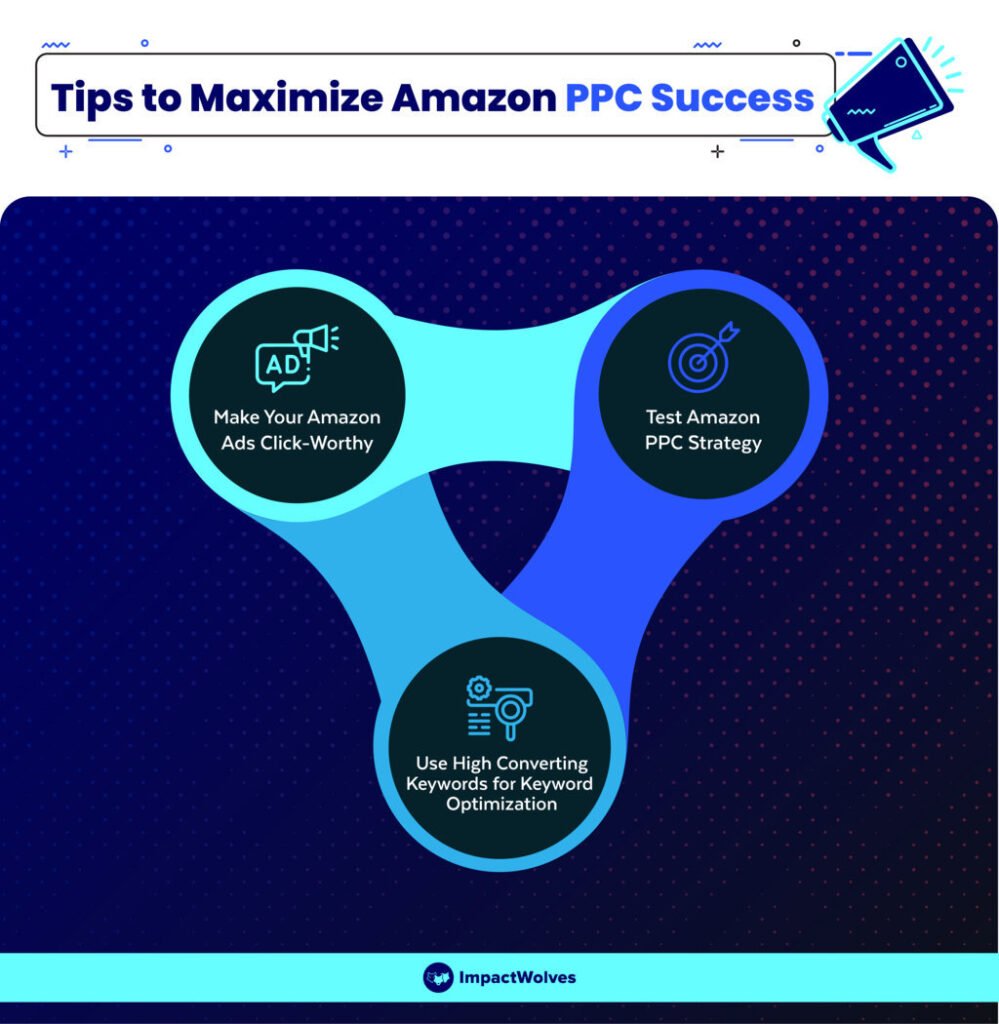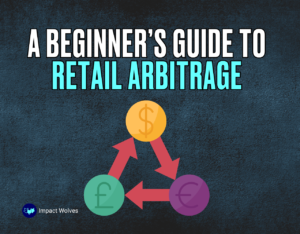If you’re an eCommerce seller on Amazon, you’re probably familiar with their advertising model and how important it is for success. But even with all your hard work and dedication to developing and fine-tuning your Amazon PPC strategy, it’s not uncommon to fall short of your goals.
Don’t worry, it happens to the best of us!
Starting out on a new platform can be challenging, and mistakes are bound to happen. However, it’s essential to keep improving your strategy if you want to achieve your objectives and get the most out of your investment.
That’s why we’ve put together a guide to help you avoid the common mistakes that eCommerce sellers often make when managing their Amazon marketing initiatives.
Here are 9 Amazon PPC optimization mistakes and how to fix them!
So, let’s dive in and take your advertising efforts to the next level!
But first…
Is Amazon PPC Worth It?
Did you know that Amazon generated $37.7 billion of its 2022 revenue from advertising alone?
Even though this stat is pretty convincing, we know many of you are still uncertain whether investing in Amazon’s PPC platform is worth it.
It’s a valid question, and there are some good reasons for being skeptical.
- Amazon has been working hard to improve its advertising ecosystem, but if you don’t have experience with PPC techniques or access to Amazon PPC expert guidance, it can be tough to know how to make the most of paid campaigns to drive sales.
- Plus, launching and managing an advertising campaign requires a financial commitment that can’t be ignored.
However, it’s important to remember that running a business often means investing money upfront to make money down the line. Even if you’re trying to cut costs, attracting more visitors and increasing sales from different sources, including PPC weekly ads and Amazon paid search, is critical to improving your Amazon search rankings.
Another thing to keep in mind is that
- Amazon’s audience is primarily made up of people who are actively looking to buy products. This sets it apart from platforms like Google and other search engines, giving Amazon an edge when it comes to showcasing its products to a ready-to-purchase audience.
Overall, having a well-planned Amazon PPC strategy can be a game-changer for your business, leading to better search rankings, more sales, and increased brand visibility.
If you’re new to Amazon’s advertising algorithms, it’s a good idea to educate yourself on common advertising management mistakes made by other advertisers.
9 Amazon PPC Optimization Mistakes and How to Fix It
Have you been feeling a little frustrated with your Amazon PPC campaign lately?
You’ve put in a lot of effort with careful planning, bidding, and refining, but it seems like you’re not seeing the results you were hoping for.

Don’t worry, it happens to the best of us!
There could be a few common mistakes that you’ve made which are preventing your campaign from succeeding. By exploring these mistakes, you might just find the insights you need to get your campaign back on track and achieve the success you deserve.
1. Using a Google Ads Mentality for Amazon Ads
Being an e-commerce seller using Amazon as your primary platform, it’s important to understand that optimizing for Amazon SEO is different than optimizing for Google.
To succeed on Amazon, it’s essential to tailor your advertising strategies to align with Amazon’s A10 algorithm. This means conducting thorough keyword research to understand how customers search for products on Amazon.

In the case of Google PPC campaigns, success is evaluated based on metrics such as:
- Click-Through-Rates (CTR)
- Keyword relevance
- Ad copy relevance
- LandingpPage relevance
- Historical performance.
However, with Amazon PPC ads, you have access to a wider range of data, including:
- CTR
- Conversion rates
- Total units sold
- Optimization of title tags for search engines
- Defining product characteristics
- Brand relevance
- Keyword-specific conversions.
So, it’s important to keep these factors in mind when creating your Amazon PPC campaigns.
2. Amazon PPC Campaign Structure and Strategy Challenges
When you’re working on your Amazon PPC campaign, it’s important to remember that long-term profitability should be your top priority.
This means creating advertising formats and strategies that will help you achieve sustainable success.
To get started, it’s a good idea to clearly define your objectives. A well-structured campaign strategy can make everything easier to understand, promote transparency, and help you keep track of everything.
3. Overlooking the Importance of Keyword Research
Finding the right balance of keywords on Amazon can be quite a challenge.
Conducting thorough keyword research is key to success for Amazon advertising. Picking the wrong keywords could lead to a decrease in sales and higher advertising costs.

One of the great things about advertising on Amazon is that you can track which keywords are driving the most success for your products. It’s a good idea to try out anywhere from 50 to 500 keywords for each ad group to see what works best.
Also, don’t forget about keyword harvesting!
This means gathering relevant keywords from automatic campaigns, external sources, and other platforms to make your manual campaigns even more effective.
4. Launching New Products Using Auto Campaigns Only
Avoid relying solely on automatic campaigns for keyword research, as it might not give you the best results!
It is a common mistake to use automatic campaigns during a product launch. This can be confusing for Amazon’s algorithm, which might not fully understand your product and its relevance.
To ensure your product’s placement in search results, we recommend
- Starting with targeted manual campaigns during your launch.
- Gradually add automatic campaigns to your strategy a few weeks later.
This will help you to create a more comprehensive campaign structure and give Amazon’s algorithm a better understanding of your product.
5. Disregarding Amazon Match Types in Your Amazon PPC Strategy
Figuring out the right search phrases that customers might use to find your product on Amazon can be quite a challenge. But don’t worry, we have a solution! To help you identify the best keywords and reach new clients, we use something called “keyword match types.”
Keyword match types make it easier for you to target the right audience and avoid showing your product to people who have little interest in it.

There are three types of keyword matches you should know about:
Exact Match Type
The exact match type is great because it ensures that your ad will only show up when a customer’s search term matches your specified keyword exactly. This way, you can be sure that your ad is being seen by people who are actively seeking products just like yours.
Broad Match Type
Broad match type offers the widest reach among all the keyword match types. When you use broad match keywords, your ad will display when all the keywords in the customer’s search term are present. This means that even if someone uses a plural form or an abbreviation, your ad could still show up.
Phrase Match Type
Phrase match type is perfect for when you want a little more control over who sees your ad. To activate this match type, the customer’s search term must contain the exact phrase or a closely similar sequence to the target keyword.
The result? Your ad won’t show up for customer queries that include terms within the middle of your specified phrase.
However, keep in mind that when you create different versions of a keyword with different bidding amounts, the search engine will show the version with the highest bid.
To get the most out of your campaign, it is recommended to:
- Bid highest on exact keywords
- A bit lower on phrase match variations
- Lowest on broad match types.
6. Focusing Solely on ACoS Tracking
When it comes to Amazon PPC optimization, it’s super important to keep an eye on all the metrics, especially ACoS (Advertising Cost of Sales). To calculate your ACoS, just divide your total campaign spending by the total sales generated.
While it’s always good to aim for a lower ACoS, it’s important to remember that this metric alone doesn’t tell the whole story. Focusing solely on ACoS can lead to increased ad spending without any clear insights into how your ads are actually performing.

Image Source: Operation ROI
So, in addition to monitoring ACoS, it’s also important to take a look at other metrics like:
- Conversion rate
- Click-through rate
A high CR and CTR can lead to better bidding performance and increased sales.
CR shows how well you’re converting clicks into sales, while CTR measures how relevant your product is to potential customers.
As a general rule of thumb, a good CR is around 10%, a CTR of 0.5% or higher is considered favorable, and ACoS usually falls between 15% and 30%.
However, these numbers can vary depending on your specific niche, product type, profit margins, and advertising goals.
7. Going Out of Stock
While optimizing your PPC campaigns, many sellers forget about managing their inventory. Believe it or not, running out of stock can have serious consequences and result in unnecessary expenses!
One of the essential components of Amazon’s Retail Readiness Checklist is ensuring that your products are available in stock. This means it’s your responsibility to keep an eye on your inventory and restock when needed to avoid any stockouts.

If you run PPC campaigns with no available products, it could lead to Amazon pulling your ads and negatively impacting your overall listing performance.
What do we suggest?
To avoid this, we suggest implementing effective inventory management practices that will help you maintain consistent product availability. If you’re not sure where to start, Amazon assists in multi-channel inventory management, particularly if you sell across various marketplace platforms.
They offer a free software tool known as Veeqo, which monitors your inventory across different channels, locations, and Fulfillment by Amazon (FBA) centers.
If you want to practice prudent inventory management, we suggest:
- Keeping a close eye on your inventory levels
- Restocking popular products quickly
- Running promotions to prevent spoilage and free up storage space.
Remember, effective inventory management is key to maintaining a successful PPC campaign!
8. Not Reviewing and Adjusting your Amazon PPC Campaign
Taking care of your PPC campaigns is like taking care of a growing plant; it needs consistent love and attention.
Market dynamics are always changing, and competition levels can be unpredictable. That’s why it’s crucial to revisit and fine-tune your Amazon PPC campaigns regularly to ensure they remain efficient and profitable.
Unfortunately, achieving top seller status on Amazon requires more than just hitting the ‘launch’ button. It takes an active approach and consistent effort to see the results you want.
- One way is to set aside some time each week to review your campaigns and make any necessary tweaks.
- Plus, when you’re reviewing your ads, keep your campaign objectives in mind and take a look at important metrics like conversion rate, CTR, and ACoS.
- If you notice that things could be performing better, consider making some bid adjustments or optimizing your keywords.
Ultimately, the key is to find the PPC strategy that works best for you and your brand.
9. Not Availing Services of Amazon PPC Specialist
Finding the right keywords for your ads can be a daunting task, but don’t worry; there are plenty of useful tools available out there to help you out. However, relying solely on them and assuming that “AI will handle everything” might not be the best approach.
Some sellers think that by using these tools, they can completely offload the responsibility of selecting campaign keywords, saving time and money that they would otherwise spend on hiring a professional.
But the truth is, they’re mistaken!
While AI and software are getting better at what they do, marketing managers should always remember to keep that ‘human touch’ when assessing results.
This is where an Amazon expert enters the picture!
An Amazon advertising agency can be a big help. They know how to reduce your PPC costs, increase your revenue, and identify any issues in your PPC campaigns.
However, If you plan on managing your own Amazon ads, take advantage of the Amazon Advertising education resources available through the Amazon Learning Console.
But it’s better to go for an Amazon PPC consultant.
Make sure you choose an Amazon PPC agency that not only offers Amazon PPC services but truly understands Amazon ads and doesn’t just blindly run your campaigns using third-party software.
So…
Tips to Maximize Amazon PPC Success
So, now that we’ve covered some common mistakes that people make when optimizing their Amazon campaigns, let’s take a deep dive into some amazing Amazon PPC tips to help take your business to the next level.

1. Use High Converting Keywords for Keyword Optimization
Conducting your own keyword research can be a smart move for your Amazon advertising efforts. While valuable keyword data becomes available once you’ve started advertising, gathering the highest-converting keywords on your own can help you optimize your keywords effectively and get the most value from your ad spend.
In addition, doing your own research can give you valuable insights into customer search behavior and emerging trends, which are crucial when planning your future ad campaigns.
If you’re not sure where to start, there are plenty of online keyword generator tools that can help you discover the right keywords for your products.
2. Test Amazon PPC Strategy
When you start running your Amazon PPC ad campaigns, you’re in control! You get to choose the keywords you want to bid on, set your budget, and decide how long you want your ads to run.
And the best part? Each week, you’ll be gathering fresh data to help you optimize your campaigns for success!
That’s where ad reports come in; they’re your secret weapon for fine-tuning your game. Use the data to experiment, test out new strategies, and see what works best for your campaigns.
3. Make Your Amazon Ads Click-Worthy
Apart from tweaking your keywords and other technical stuff, it’s equally important to upgrade your product descriptions and images.
Trust me, people tend to make quick judgments about your brand based on what they see in your ads!
So, it’s essential to make a lasting impression with your product listing. Your description should be so compelling that it lures your ideal customers to hit that ‘buy now’ button.
But remember, just getting them to click on your ad isn’t enough. You need to continue the charm by adding persuasive product descriptions and captivating images.
So, while mastering PPC strategies is crucial, never underestimate the power of crafting a compelling product listing!
To Sum It Up…
Have you ever felt like Amazon’s PPC world is a bit of a puzzle? Don’t worry, you’re not alone!
But the good news is that by being aware of some common slip-ups, you can find your way to more fruitful campaigns. In this guide, we have discussed 9 common Amazon PPC optimization mistakes and how to fix them.
Remember always to examine your strategies closely, be adaptable, and make sure to keep your customers at the forefront of everything you do.
And, if you think keeping track of everything is too much of a task, Impact Wolves has got you back with its Amazon PPC services.
Let us maximize your brand profitability on Amazon!




